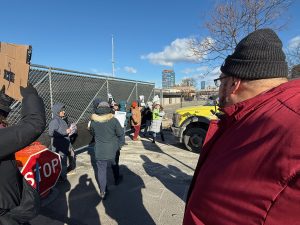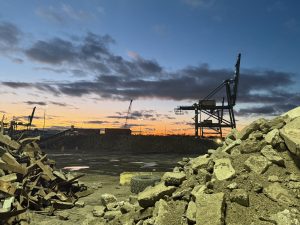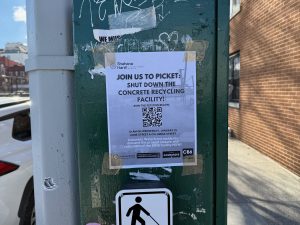
Columbia St residents briefly blocked the entrance to the concrete recycling facility after a rally in January.
By JACK DELANEY | jdelaney@queensledger.com
When two worldviews collide — in this case, the reticent number-crunching of scientists, and the lived reality of residents — the results can be explosive.
On Tuesday, May 20, neighbors from the Columbia Street Waterfront District, just south of Brooklyn Bridge Park, gathered for what they hoped would be a breakthrough. After nearly a year of asking city officials to shut down a nearby concrete recycling facility owned by the Department of Transportation (DOT) due to concerns about airborne dust, another agency — the Department of Environmental Protection (DEP) — was finally presenting three months’ worth of data about the extent of the pollution.
The only catch? That long-awaited data suggests that nothing is amiss, and the DEP is now telling locals they’ll have to look elsewhere for help.
Under the Purple Line
The waterfronters’ woes started in February of 2024, when the DOT moved its concrete recycling operation from the South Brooklyn Marine Terminal to Red Hook to accommodate a large offshore wind project. In theory, the facility is helping to reduce pollution, albeit on a grander scale: concrete production accounts for 8% of global greenhouse gas emissions, so recycling efforts have been widely praised.
Within months, however, locals were complaining of layers of dust that coated their cars and brought with it a range of anecdotal health concerns, particularly on windy days. The crushed material, known as recycled concrete aggregate (RCA), is stored on the dockyards in open-air mounds. To keep it from blowing away, the DOT ostensibly drenches the dust piles with water, yet residents allege that these mitigation efforts are implemented sporadically.
Last fall, local lawmakers including Councilmember Shahana Hanif, State Senator Andrew Gounardes, and Assemblymember Jo Anne Simon joined residents at a rally to ask that the DOT shut down or permanently relocate its facility. Parents shared their fears that their children would develop lung diseases, and neighbors traded horror stories about indoor air purifiers that were going “berserk.” The elected officials said they would meet with the mayor’s office to negotiate, but amid a chaotic situation at City Hall — the deputy mayor they were supposed to meet with, Maria Torres-Springer, resigned not long after the rally — the push for relocation hit a wall.
Instead, in January of this year, the Department of Environmental Protection installed a network of sensors near Columbia Street to ascertain whether the recycling plant is endangering residents. Last week’s meeting, organized by Community Board 6, was anticipated by many as the vindication the community had been waiting for, irrefutable evidence at last that the site needs to be shuttered.

Mounds of “recycled concrete aggregate,” or RCA, are stored in the decrepit dockyards of the Brooklyn Marine Terminal.
The uproar over the concrete recycling facility comes at a volatile moment for the Columbia Street Waterfront District, and for Red Hook as a whole. Last year, the surrounding Brooklyn Marine Terminal changed hands from the Port Authority to the NYC Economic Development Corporation, which is seeking approval to build over 8,000 units of housing in the neighborhood.
At a meeting in Carroll Gardens earlier this year, several residents made an explicit connection between the burgeoning plans for the BMT and the ongoing fight over the recycling facility, arguing that the EDC’s proposal for an additional school to accommodate the influx of tenants would be sited within blocks of the dust clouds.
Prior to the DOT facility’s arrival, the Columbia Street location was home to a colony of stray cats, and Eshete Woldeyilma, an immigrant from Ethiopia who could be spotted feeding them from his sofa chair on the sidewalk.
Before presenting their findings, DEP staffers rattled off several asterisks. First, the agency is stretched thin, said Deputy Commissioner Beth DeFalco; it only has 13 air quality monitors for all of New York City, and it relocates them every three months to cover more ground, rendering longer-term studies difficult.
Second, the report relied on two methodological choices that the residents on the Zoom would later skewer. Drisana Hughes, DEP’s recently-appointed borough commissioner for Brooklyn, explained that the sensors measure all airborne particulate matter, meaning there’s no way to isolate the prevalence of concrete dust. More controversially, the agency chose to record the data as averages of 24-hour periods, as opposed to hourly readings, and compared the results against the federal threshold for what quantity of ambient particulate matter is dangerous for humans (50 micrograms per cubic meter).
In short, the three-month study found that the daily averages were well below that purple line. With that, the DEP representatives yielded the floor for questions.
There were many.
The Community’s Rebuttal
Residents immediately challenged the decision to use daily averages, given that the pollution is dependent upon wind conditions — it may be absent for long periods of time, but when the gusts pick up, it’s severe.
“We don’t take one breath every 24 hours,” said Leah Carroll, who pressed DeFalco and Hughes on whether they would release the sensors’ continuous readings. (They said that it would be unlikely, but they would check to see if it was possible.)
Community members also expressed disbelief at the implication that the facility posed no issue, when those who live in the neighborhood have experienced it firsthand. Several audience members chimed in to say that they would send jars of dust and video footage of the billowing pollutants if the officials needed further proof. “I’m not a scientist,” said John Leyva. “I just know that people are getting sick, and that we can run our fingers over our cars and pick up all this dust.”
Even with the averaged data, some voiced concerns that any amount of particulate matter is problematic. “I am not convinced that [the threshold] is something that satisfies me as a resident and as a father of a small child,” said Jose Blanco, noting that Europe has more stringent requirements for silicates.
Ultimately, as the shock of the unexpected findings wore off, the residents shifted from clarifying questions about the report, and refocused on what it would take to move forward.
“We’re begging as a community for more inspections on windy days,” said Victoria, a Columbia Street local.
“This is beyond the scope of DEP,” said DeFalco, apologetically, before suggesting that other city agencies may be better equipped to provide more data.
But community members intimated that city officials were engaging in a game of health hazard hot-potato. “Whose responsibility is this, then?” asked Jennifer Diamond, as the chat exploded with comments.



